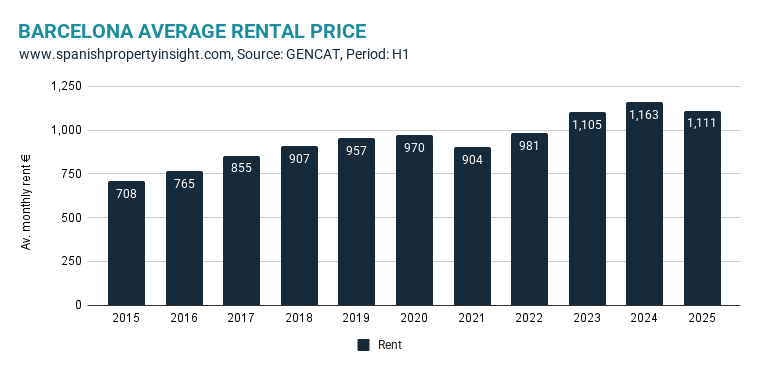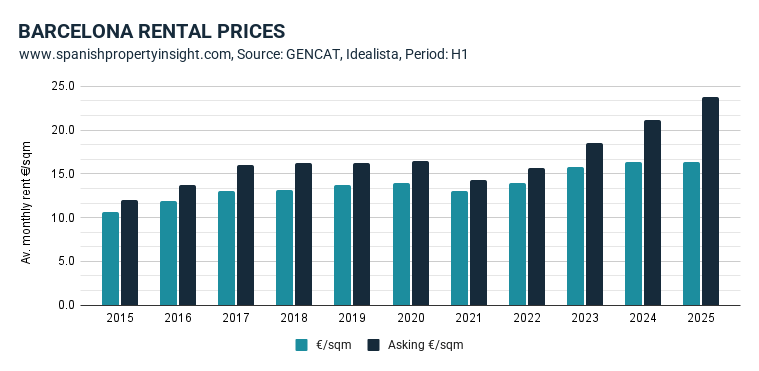

The Catalan government (Generalitat) has been busy spinning the latest rental market figures as a vindication of its rent control policy—but scratch beneath the surface, and the numbers tell a very different story.
Official spin: “price containment” success
Sílvia Paneque, the Generalitat’s Councillor for Territory, Housing and Ecological Transition, was quick to trumpet the results in the Catalan Parliament this week, citing what she called a “continued trend in price containment.” According to Paneque, there has been a “cumulative 4.9% reduction in Barcelona city and 1.9% across all officially designated stressed market areas since the policy began.” The chart above illustrates the decline in average Barcelona rental prices in H1 (-4.4%).
She also contrasted this with a “6.6% increase” in rents in areas not subject to rent caps (where a fraction of the population lives), arguing that rent controls are clearly working to “defend the right to housing” and rein in “years of excessive speculation.”
It’s a bold pitch. But it’s also a classic case of polishing a turd.
The real numbers: lower supply, not lower prices


While declared rents in official contracts did edge down slightly, asking prices on the open market soared—up over 12% year-on-year in H1 2025. Meanwhile, the number of new rental contracts in Barcelona have continued to tank. Just 15,026 were signed in the first half of 2025, down 15% from last year and over 7,000 below the ten-year average (20% down). The chart above illustrates this precipitous decline.
In Q2 alone, the number of new contracts fell to just 7,411—the lowest level on record (excluding the lockdown period). So yes, a lucky few (with the best rental profiles) are paying marginally less for increasingly scarce rental housing, but many thousands of families are now shut out of the market, even if they can afford to pay the market rate. But hey, fewer homes to rent and more people locked out—apparently that’s what success looks like now.
Rental market index shows dramatic divergence


Using 2015 as a base index (100), we can see how rental supply and prices have evolved over the last decade, taking in Barcelona’s first experiment with rent controls between Q3 2020 and Q1 2022, which coincided with the pandemic, and the lastest experiment starting in Q1 2024.
- €/sqm contract rents: index 153
- Asking prices: index 196
- Rental contracts signed: index 77
The first experiment appeared to restrain rental prices, but in reality that was due to the pandemic, which dragged down prices to the same extent in other cities like Madrid (see next chart), where there were no rent controls in place.


But rent controls sent a clear message to landlords: expect punishment. Many have been leaving the market ever since.
This stark divergence makes it clear: rent controls are strangling supply while doing little to reduce prices.
More homes for rent? A convenient fudge
In a further attempt to salvage the narrative, Paneque pointed to what she claimed was a “positive balance” of 2,285 more rental contracts across Catalonia in Q2 2025 and 14,124 more since the start of the policy. But this figure includes all ongoing rental contracts, not just new ones—so it says little about access for those looking for a home today.
Nor does it square with the hard data from INCASOL showing a steep decline in new contracts being signed in Barcelona, the region’s most important rental market.
Why more rental contracts doesn’t mean better access to housing
The total number of rental contracts can increase even as new contracts decline because rent controls reduce tenant mobility—people stay put to hold onto capped rents, meaning fewer homes turn over and fewer new contracts get signed.
Think of the rental market as a population of rental contracts. The total number of contracts is like the population, and the number of new contracts is like immigration—new entries into the system. Meanwhile, contracts ending or tenants moving out are like emigration—exits from the system.
Here’s the dynamic under rent controls:
- New contracts (immigration) are falling, because there are fewer homes coming onto the market—landlords are less willing to rent under capped prices, and fewer people are moving out.
- Existing tenants are staying put (lower emigration) because they have a good deal and don’t want to lose it. In normal conditions, some of them would move for a job, buy a home, or upsize/downsize, freeing up a rental. Under rent controls, many choose not to move at all.
So even with a sharp fall in new contracts, the net total of active contracts can still rise if fewer people are leaving. That’s how the Generalitat can claim that there are “more contracts than before,” even as new rental opportunities for would-be tenants have collapsed.
But that increase doesn’t reflect better access—it reflects reduced turnover and tighter market stagnation.
Blaming the past, ignoring the present
“The housing crisis,” Paneque said, “is the most visible wound of an economic system that has tolerated excessive speculation.” And while she insisted that the government’s housing strategy is a national priority built on “planning, dialogue and coherence,” the reality on the ground is that rent controls have pushed the market further into dysfunction.
In a high-demand city like Barcelona, the unintended consequences of these regulations—lower supply, longer queues, greater informality—are anything but coherent. While some lucky tenants may enjoy lower rent, thousands of others are locked out entirely, or paying under-the-table to meet the real market price.


No amount of spin can hide the damage
One year on, rent controls in Barcelona have delivered exactly what many warned: a smaller, murkier rental market that helps a few while hurting the rest. And while officials keep dressing it up as success, for most people trying to find a home to rent in Barcelona, it’s mission impossible.